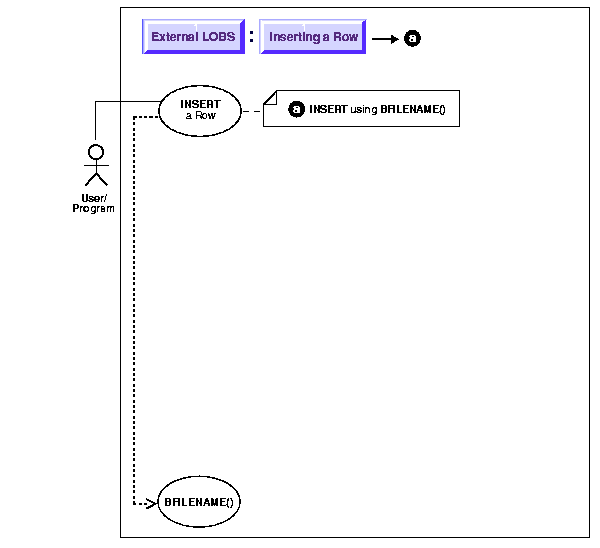Release 1 (9.0.1)
Part Number A88879-01
Home |
Book List |
Contents |
Index | Master Index | Feedback |
| Oracle9i Application Developer's Guide - Large Objects (LOBs) Release 1 (9.0.1) Part Number A88879-01 |
|
External LOBs (BFILEs), 11 of 41

|
See Also:
"Use Case Model: External LOBs (BFILEs)" for all basic operations of External LOBs (BFILES). |
This procedure describes how to insert a row using BFILENAME().
Call BFILENAME() function as part of an INSERT to initialize a BFILE column or attribute for a particular row, by associating it with a physical file in the server's filesystem.
Although DIRECTORY object, represented by the directory_alias parameter to BFILENAME(), need not already be defined before BFILENAME() is called by a SQL or PL/SQL program, the DIRECTORY object and operating system file must exist by the time you actually use the BFILE locator. For example, when used as a parameter to one of the following operations:
You can use BFILENAME() in the following ways to initialize a BFILE column:
You can use BFILENAME() to initialize a BFILE locator variable in one of the programmatic interface programs, and use that locator for file operations. However, if the corresponding directory alias and/or filename does not exist, then for example, PL/SQL DBMS_LOB or other relevant routines that use this variable, will generate errors.
The directory_alias parameter in the BFILENAME() function must be specified taking case-sensitivity of the directory name into consideration.
See Chapter 3, "LOB Support in Different Programmatic Environments" for a list of available functions in each programmatic environment. Use the following syntax references for each programmatic environment:
Examples are provided in the following six programmatic environments:
The following examples illustrate how to insert a row using BFILENAME().
/* Note that this is the same insert statement as applied to internal persistent LOBs but with the BFILENAME() function added to initialize the BFILE columns: */ INSERT INTO Multimedia_tab VALUES (1, EMPTY_CLOB(), EMPTY_CLOB(), FILENAME('PHOTO_DIR', 'LINCOLN_PHOTO'), EMPTY_BLOB(), EMPTY_BLOB(), VOICED_TYP('Abraham Lincoln', EMPTY_CLOB(),'James Earl Jones', 1, NULL), NULL, BFILENAME('AUDIO_DIR','LINCOLN_AUDIO'), MAP_TYP('Gettysburg', 23, 34, 45, 56,EMPTY_BLOB(), NULL));
/* Insert a row using BFILENAME: */ void insertUsingBfilename(svchp, stmthp, errhp) OCISvcCtx *svchp; OCIStmt *stmthp; OCIError *errhp; { text *insstmt = (text *) "INSERT INTO Multimedia_tab VALUES (3, EMPTY_CLOB(), \ EMPTY_CLOB(), BFILENAME('PHOTO_DIR', 'Lincoln_photo'), \ EMPTY_BLOB(), EMPTY_BLOB(), NULL, \ NULL, BFILENAME('AUDIO_DIR', 'Lincoln_audio'), \ MAP_TYP('Gettysburg', 23, 34, 45, 56, EMPTY_BLOB(), NULL))"; /* Prepare the SQL statement */ checkerr (errhp, OCIStmtPrepare(stmthp, errhp, insstmt, (ub4) strlen((char *) insstmt), (ub4) OCI_NTV_SYNTAX, (ub4)OCI_DEFAULT)); /* Execute the SQL statement */ checkerr (errhp, OCIStmtExecute(svchp, stmthp, errhp, (ub4) 1, (ub4) 0, (CONST OCISnapshot*) 0, (OCISnapshot*) 0, (ub4) OCI_DEFAULT)); }
This script is also provided in $ORACLE_HOME/rdbms/demo/lobs/cobol/finsertn
IDENTIFICATION DIVISION. PROGRAM-ID. BFILE-INSERT. ENVIRONMENT DIVISION. DATA DIVISION. WORKING-STORAGE SECTION. 01 USERID PIC X(11) VALUES "SAMP/SAMP". 01 ORASLNRD PIC 9(4). EXEC SQL INCLUDE SQLCA END-EXEC. EXEC ORACLE OPTION (ORACA=YES) END-EXEC. EXEC SQL INCLUDE ORACA END-EXEC. PROCEDURE DIVISION. BFILE-INSERT. EXEC SQL WHENEVER SQLERROR DO PERFORM SQL-ERROR END-EXEC. EXEC SQL CONNECT :USERID END-EXEC. EXEC SQL INSERT INTO MULTIMEDIA_TAB (CLIP_ID, PHOTO) VALUES (1, BFILENAME('PHOTO_DIR', 'LINCOLN_PHOTO')) END-EXEC. EXEC SQL ROLLBACK WORK RELEASE END-EXEC. STOP RUN. SQL-ERROR. EXEC SQL WHENEVER SQLERROR CONTINUE END-EXEC. MOVE ORASLNR TO ORASLNRD. DISPLAY " ". DISPLAY "ORACLE ERROR DETECTED ON LINE ", ORASLNRD, ":". DISPLAY " ". DISPLAY SQLERRMC. EXEC SQL ROLLBACK WORK RELEASE END-EXEC. STOP RUN.
This script is also provided in $ORACLE_HOME/rdbms/demo/lobs/proc/finsertn
#include <oci.h> #include <stdio.h> #include <sqlca.h> void Sample_Error() { EXEC SQL WHENEVER SQLERROR CONTINUE; printf("%.*s\n", sqlca.sqlerrm.sqlerrml, sqlca.sqlerrm.sqlerrmc); EXEC SQL ROLLBACK WORK RELEASE; exit(1); } void BFILENAMEInsert_proc() { EXEC SQL WHENEVER SQLERROR DO Sample_Error(); EXEC SQL WHENEVER NOT FOUND CONTINUE; /* Delete any existing row: */ EXEC SQL DELETE FROM Multimedia_tab WHERE Clip_ID = 1; /* Insert a new row using the BFILENAME() function for BFILEs: */ EXEC SQL INSERT INTO Multimedia_tab VALUES (1, EMPTY_CLOB(), EMPTY_CLOB(), BFILENAME('PHOTO_DIR', 'Lincoln_photo'), EMPTY_BLOB(), EMPTY_BLOB(), NULL, InSeg_tab(InSeg_typ(1, NULL, 'Ted Koppell', 'Abraham Lincoln', BFILENAME('AUDIO_DIR', 'Lincoln_audio'), EMPTY_CLOB())), BFILENAME('AUDIO_DIR', 'Lincoln_audio'), Map_typ('Moon Mountain', 23, 34, 45, 56, EMPTY_BLOB(), BFILENAME('PHOTO_DIR', 'Lincoln_photo'))); printf("Inserted %d row\n", sqlca.sqlerrd[2]); } void main() { char *samp = "samp/samp"; EXEC SQL CONNECT :samp; BFILENAMEInsert_proc(); EXEC SQL ROLLBACK WORK RELEASE;}
Dim OraDyn as OraDynaset, OraPhoto as OraBFile, OraMusic as OraBFile Set OraDyn = OraDb.CreateDynaset("select * from Multimedia_tab", ORADYN_DEFAULT) Set OraMusic = OraDyn.Fields("Music").Value Set OraPhoto = OraDyn.Fields("Photo").Value OraDyn.AddNew OraDyn.Fields("Clip_ID").value = 1 OraDyn.Fields("Story").value = Empty 'This is equivalent to EMPTY_BLOB() in SQL OraDyn.Fields("FLSub").value = Empty 'Initialize BFile Data:OraPhoto.DirectoryName = "PHOTO_DIR" OraPhoto.FileName = "LINCOLN_PHOTO" OraDyn.Fields("Frame").Value = Empty OraDyn.Fields("Sound").Value = Empty 'Initialize BFile Data:OraMusic.DirectoryName = "AUDIO_DIR" OraMusic.FileName = "LINCOLN_AUDIO" OraDyn.Update 'Add the row to the table
import java.io.InputStream; import java.io.OutputStream; // Core JDBC classes: import java.sql.DriverManager; import java.sql.Connection; import java.sql.Statement; import java.sql.PreparedStatement; import java.sql.ResultSet; import java.sql.SQLException; // Oracle Specific JDBC classes: import oracle.sql.*; import oracle.jdbc.driver.*; public class Ex4_21 { public static void main (String args []) throws Exception { // Load the Oracle JDBC driver: DriverManager.registerDriver(new oracle.jdbc.driver.OracleDriver()); // Connect to the database: Connection conn = DriverManager.getConnection ("jdbc:oracle:oci8:@", "samp", "samp"); conn.setAutoCommit (false); // Create a Statement: Statement stmt = conn.createStatement (); try { stmt.execute("INSERT INTO multimedia_tab " +"VALUES (99, EMPTY_CLOB(), EMPTY_CLOB(), " +"BFILENAME ('PHOTO_DIR','Lincoln_photo'), " +"EMPTY_BLOB(), EMPTY_BLOB(), " +"(SELECT REF(Vref) FROM Voiceover_tab Vref " +" WHERE Actor = 'James Earl Jones'), NULL, " +"BFILENAME('AUDIO_DIR', 'Lincoln_audio'), " +"MAP_TYP('Gettysburg', 23, 34, 45, 56, EMPTY_BLOB(), NULL))"); // Commit the transaction: conn.commit(); stmt.close(); conn.close(); } catch (SQLException e) { e.printStackTrace(); } } }
|
|
 Copyright © 1996-2001, Oracle Corporation. All Rights Reserved. |
|